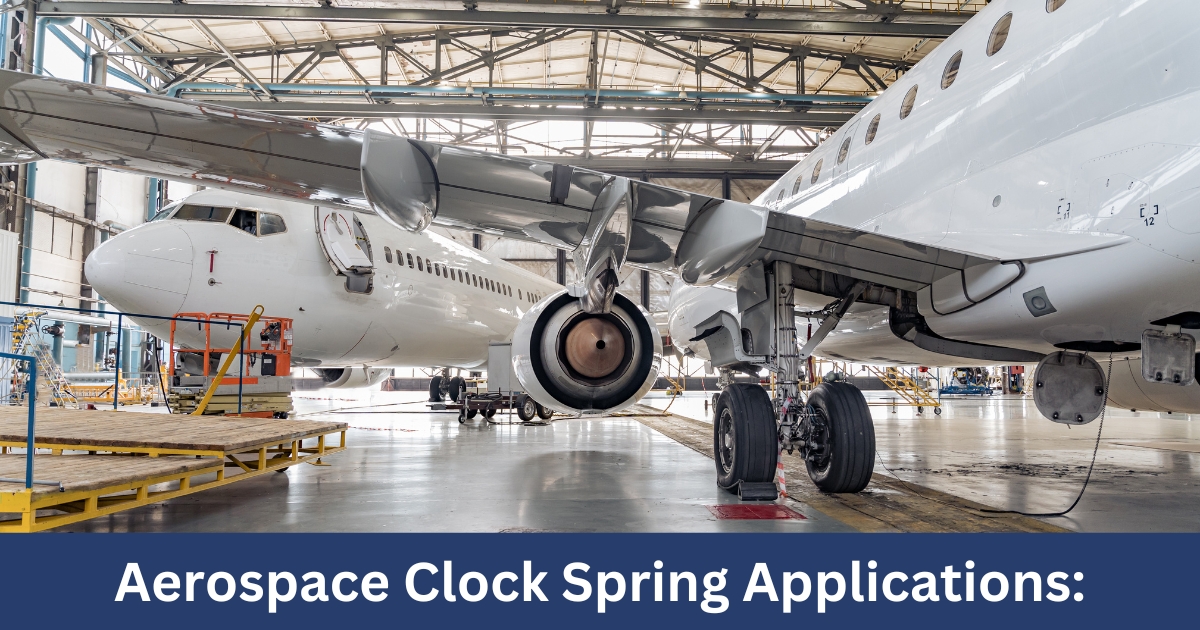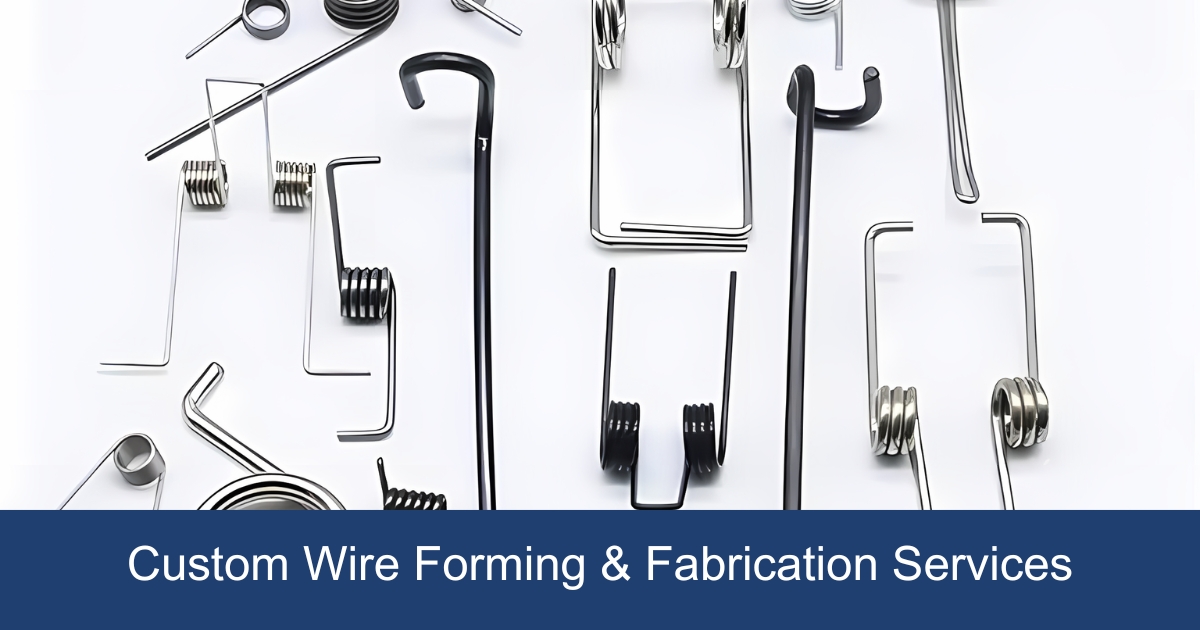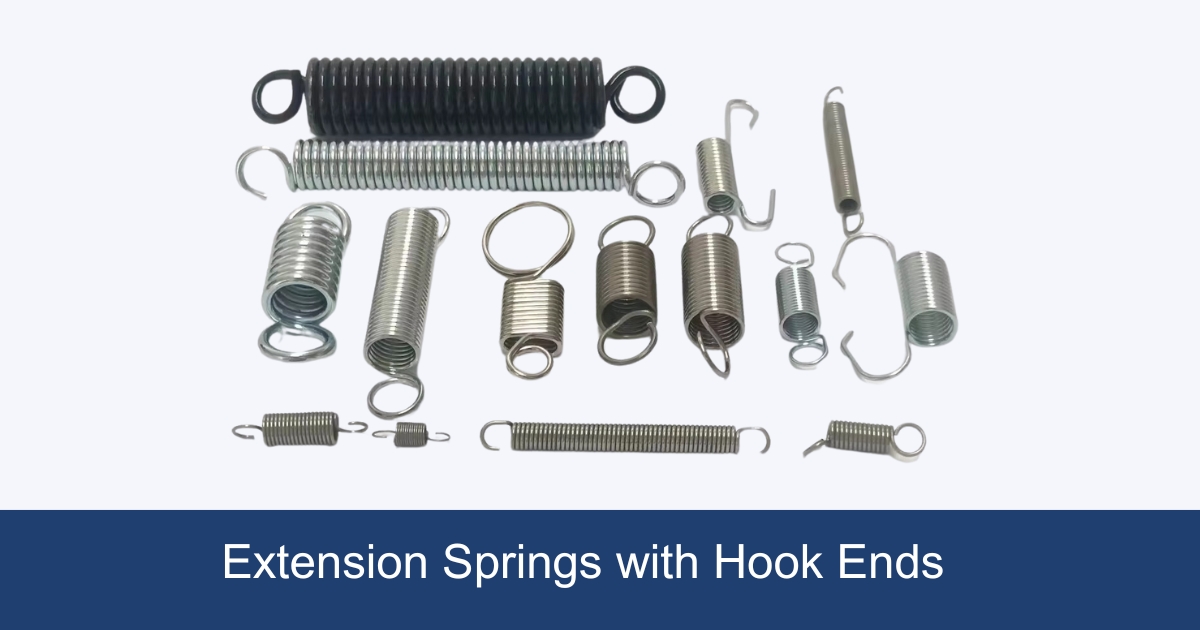Key Takeaways
- Designed to absorb and store energy, extension springs are used in a wide variety of applications.
- Hook end springs have hooks, making them easy to attach and more usable across various setups.
- Benefits of hook end springs include flexibility, ease of installation, and reliability under tension.
- When selecting hook end springs, consider your load requirements, spring length, and material.
- Proper installation techniques are important to maximize the life and effectiveness of hook end springs.
- Following best practices, including regular inspections and not overstretching, can extend the life of hook end springs.
Extension springs with hook ends have existed for years. They’re useful tools in a range of applications, from garage doors to toys.
They stretch and pull back, which makes them ideal for tension needs. The right spring will help to supercharge the efficiency of your project.
You’ll discover tips for selecting the best ones for your jobs. As long as you install them correctly, they keep everything chugging along. We’ll even share simple steps to make it easy.
So, get ready to get into the game and check out what extension springs can do for you.
What Are Extension Springs?
Key Characteristics of Extension Springs
When you understand extension springs, particularly the stock extension springs, you grasp their unique characteristics. These springs are tightly coiled for energy storage, and when stretched, they snap back with authority. This tension-based design sets them apart from compression springs, which resist being squeezed.
Standard extension springs feature hooks or loops on each end, facilitating easy attachment to other components. This design allows for versatile use in various machines, making them ideal for applications like garage door assemblies and farm machinery.
Most extension springs are made from corrosion-resistant materials, such as stainless steel or high-carbon steel, ensuring durability against wear and environmental stress. This quality is crucial for maintaining performance in demanding environments.
The coils in extension springs rest closely together when not under load, unlike compression springs, whose coils are spaced out. This compact configuration contributes to their efficiency and effectiveness in mechanical components.
Understanding the spring design process and the role of wire diameter can enhance your ability to select the right spring for specific applications. By considering factors like total coils and maximum force, you can achieve precise tension control for optimal performance.
Common Applications of Extension Springs
Extension springs, a crucial component in various applications where pulling force is required, are ideal for ensuring that systems maintain precise control of force. For instance, when you stretch an extension spring, its coiled design generates resistance, which is a significant feature in the spring design process.
- Automotive: You’ll see them in brakes and seat mechanisms.
- They play a role in tensioning belts and pulleys.
- Look for them in garage doors, trampolines, and window screens.
As the spring is pulled, this resistance grows, offering constant support regardless of weight. This characteristic makes stock extension springs particularly valuable in applications like garage door assemblies and trampolines, where reliable extension performance is essential.
The ability of these springs to manage operational loads is enhanced by their calculated load and spring rate, ensuring they can handle specific demands effectively. Their versatility allows engineers to utilize them in a wide selection of projects, from lightweight household products to heavy-duty machinery.
In addition, the use of quality spring steel in the construction of extension springs contributes to their durability and performance. With the right specifications and testing, these springs can meet the unique demands of various applications, providing a true load capacity and effective tension control.
How Extension Springs Work
To understand how these springs operate, ask someone how these springs store energy and then release it when they are stretched.
Each spring has an initial tension — a pre-loaded force that needs to be overcome before it begins to extend.
This feature makes them ideal for applications where controlled pulling forces are required or where energy must be absorbed and released.
When you apply a load to an extension spring, it stretches and creates a restoring force. This force assists equipment in returning to its starting position or maintains it in a static position despite any load variation.
Most furniture, like a couch, uses extension springs, which also increase comfort. They allow parts to move smoothly while keeping the whole.
Extension springs are pervasive parts of diverse industries.
Their design and function contribute significantly to the efficiency and reliability of mechanical systems.
Features of Hook End Springs
Material Composition
To provide strength and longevity, hook end springs utilize durable materials such as stainless steel, carbon steel, and galvanized steel. These materials not only stand up well to corrosion and high stress but also contribute to the overall spring design, ensuring reliable extension performance in various applications.
For some applications, springs can leverage specialized materials like piano wire or beryllium copper, which provide additional protection from heat or chemicals. This choice of material allows the springs to work effectively in rugged environments, making them ideal for industrial machinery and demanding operational loads.
The use of high-quality spring steel in the construction of these springs ensures they maintain their functionality over time. This attention to material selection enables the springs to meet unique demands, providing effective solutions for both lightweight household products and heavy-duty machinery applications.
Design Variations
Both end hooks are uniquely designed to help your spring do the job it’s meant to do.
The hook ends act as secure attachment points, letting the spring easily connect to rods or fixtures.
Various types of hooks include machine hooks, crossover center hooks, side hooks, and swivel hooks, each serving a specific purpose.
Each type boasts varying degrees of flexibility and durability depending on the application.
You can also customize the length, angle, and thickness of the hooks for specific needs.
Load Capacity
This is why load capacity is crucial to understand when choosing hook end springs.
The tight coils of these springs mean they can handle a lot of tension forces.
That initial tension is important; that’s the force you need to get the spring moving.
A specific part number begins with an initial tension of 2 lbs. This tension makes up 2% of its total load capacity.
Key is realizing how far the spring has to travel. It ensures that the spring provides the appropriate amount of force during its actuation.
Benefits of Hook End Springs
Versatility in Applications
To get a sense of the benefits, let’s take a look at how extension springs fit into various uses. These springs have attachment points that hold on well to any number of components, enhancing their tension capabilities. This connection reduces the risk of disconnection when under tension, making them ideal for applications requiring precise tension control.
Consider automotive parts or industrial machines; stability and safety are paramount. The use of stock extension springs ensures that these components can withstand operational loads without failure. You can also look for different hook designs for easy installation. Whether you need crossover, machine style, or side style, these options add flexibility to your projects.
Hook end springs perform well in applications where pulling force must be controlled. They are particularly effective in brake mechanisms and door closers, where they can soak up and release energy efficiently. The spring design process involved in creating these springs allows for various end types, ensuring they meet specific application requirements.
In addition, the quality spring steel used in these springs contributes to their durability and performance. This material choice is crucial for applications that experience significant tension and fatigue over time. When selecting springs, consider the spring rate and spring constant to ensure they meet your project’s demands.
Overall, extension springs provide a reliable solution for a wide range of applications, from automotive to household products. Their ability to maintain tension and flexibility makes them a great advantage in various designs, ensuring safety and efficiency in their operation.
Cost-Effectiveness
When it comes to bargain options, hook end springs sparkle.
They’re a smart investment that doesn’t bankrupt you.
Many (from furniture to aerospace) rely on these springs because they add a lot of value.
You’ll discover that as much as 80% of the cost of a spring is directly related to its design. So what type you choose matters quite a bit.
Another plus is customization. If you can’t find the exact spring you need, companies such as KENENG can fabricate one for you.
This ability to adapt makes hook end springs not only affordable but also practical.
Durability and Longevity
One of the primary benefits of hook end springs is durability.
Made from materials like stainless steel or carbon steel, these springs are resistant to corrosion and wear.
This quality makes them effective even in harsh conditions, such as outdoor environments and industrial spaces.
High fatigue resistance is a factor as well. These springs accommodate repeated stretching without shape loss.
Consider using them in garage doors or machinery, and they just keep working the way they are supposed to over time.
Their compact design saves space while still providing strong tension. This allows for efficient designs for smaller devices.
Choosing the Right Hook End Springs
1. Assess Application Requirements
Define your application to determine the correct type of extension springs with appropriate hook end configurations. It’s essential to assess the load capacity, specifically the maximum force that the spring needs to handle. Heavy machinery often requires springs designed with high tension capabilities to support substantial operational loads without bowing.
When using a spring in a confined space, evaluate the available distance for it to stretch and retract. A compact design with a smaller diameter and closely coiled system may necessitate the use of stock extension springs. Understanding the spring design process is crucial for ensuring optimal performance in tight environments.
Additionally, consider the initial resistance and how it correlates with the spring’s ability to return to its original length after being loaded. This aspect is particularly important when selecting springs for applications in heavy machinery, where precise tension control is vital for safe operation.
Lastly, ensure that the selected springs meet the unique demands of your application by consulting an extensive catalog of custom extension springs. This will provide you with various options tailored to your specific requirements, ensuring reliability and efficiency in your machinery or equipment.
2. Determine Load Specifications
Next, consider your load specs when selecting stock extension springs. The maximum allowable stress for these springs typically falls between 30% and 45% of the minimum tensile strength of the material. Therefore, when you choose a spring, ensure it can hold your particular load without failing over time, providing reliable extension performance.
Pay attention to how much initial tension the extension spring has. Most extension springs come pre-loaded, which means they require some force to begin the act of extending. For example, part number PE045-500-36333-MW-2500-CO-N-IN has an initial tension of 0.913 lbf, making it essential to understand the spring design and its tension capabilities for your application.
When evaluating the spring’s characteristics, consider the spring constant and how it affects the overall performance. The spring rate is crucial for determining how much force is needed for a specific distance of elongation. A well-designed extension spring will have optimal stiffness and be able to handle operational loads effectively.
In addition, the wire diameter and coil configuration play a significant role in the spring’s durability and functionality. Understanding these parameters will help you select the perfect spring for your needs, ensuring it meets the unique demands of your specific application while maintaining safety retention and performance over time.
3. Consider Environmental Factors
Consider environmental factors.
A lot of this has to do with the material of your spring. Stainless steel provides excellent corrosion resistance, which is ideal for outdoor or wet environments. Carbon steel is durable and inexpensive for indoor applications. Galvanized steel resists rust thanks to its zinc coating and also performs well in humid environments. If you work with extreme heat or chemical exposure, look for specialty alloys designed for those conditions.
4. Evaluate Spring Dimensions
Next, measure the dimensions of the spring, beginning with the wire diameter. Heavier loads will necessitate a thicker wire to prevent deformation, making the choice of quality spring steel crucial. Additionally, measure the outside diameter, as this plays a significant role in fitment within your setup and should align with your space constraints.
Next, assess the free length of the spring when it is not extended. This measurement provides an accurate idea of how much the spring will stretch during operation, which is essential for understanding its performance in various applications.
By taking these measurements into account, you can ensure that your spring design meets the required specifications for its intended use, whether it be for industrial machinery or lightweight household products. This attention to detail will ultimately lead to more reliable extension springs and better overall performance.
Applications of Hook End Springs
Industrial Uses
To see how hook end springs work in industry, check out some machines that utilize stock extension springs. These springs maintain tension in belts and chains, ensuring that conveyor systems run smoothly. When tension remains constant, there’s less slippage and misalignment, translating to less downtime and more productivity for businesses.
In safety mechanisms, extension springs play a big role; they hold parts securely but let go easily when needed. This precise tension control is crucial for operational safety. For machines with moving components, they provide a return force, allowing parts to return to their original position after movement.
The design of these springs, often referred to as spring design, involves careful consideration of factors like wire diameter and coil configuration. By optimizing these parameters, engineers can create springs that meet specific demands in various applications.
In addition, the quality spring steel used in manufacturing ensures durability and reliability under operational loads. This quality is essential for maintaining the performance of machines in demanding environments, including industrial and agricultural machinery.
Ultimately, the effectiveness of hook end springs lies in their ability to provide consistent tension and support. Their role in enhancing productivity and safety makes them a vital component in modern machinery, showcasing the importance of precision in spring design.
Household Applications
You’ll find hook end springs in various household items. Think of door hinges or drawer slides.
These springs keep the right tension, so everything works seamlessly. They make opening and closing easy.
Even in heavy-duty doors and gates, these springs stand out.
They offer a secure closure but still allow easy access.
Their design allows them to latch onto fixtures easily and keep everything in place.
Automotive Integration
In the automotive world, you need extension springs with hook ends. For brake mechanisms, they provide the required tension spring force for retraction, allowing brake parts to return to their original length after use. Without this crucial function, brakes could fail to engage properly, potentially leading to safety issues.
These springs also work effectively for trunk and hood latches. By maintaining tension capabilities in latch mechanisms, these springs ensure stability during movement. In suspension systems, they absorb shocks, contributing to vehicle stability and comfort.
With a wide selection of stock extension springs, engineers can choose the right spring design that meets specific demands for various applications. The spring design process takes into account factors like wire diameter and coil configuration to ensure optimal performance.
Moreover, understanding the spring rate and spring constant is essential for selecting springs that can handle operational loads effectively. By calculating the total force needed for each application, manufacturers can provide reliable solutions for automotive needs.
In conclusion, the use of custom extension springs in automotive applications is vital for ensuring safety and functionality. Their ability to maintain tension control and absorb shocks makes them indispensable in modern vehicle design.
Installation Tips for Hook End Springs
Proper Alignment Techniques
For hook end springs, the first step in installing hook end springs is to properly align the spring.
Place one hook end into a fixed point. Make sure it locks into place. Then, carefully stretch the spring to hook the other end to its spot.
Seek uniform tension around the spring. This balance prevents wear and tear.
Check the alignment after installing them.
Over time, that misalignment leads to failure.
If you see anything uneven, adjust right away. You may need a level.
This small fix will prevent headaches down the road.
Safety Precautions
When working with springs, safety is a top priority.
Always wear safety goggles to protect your eyes from flying debris.
Springs snap back unexpectedly, especially under tension. Keep your hands clear of the spring’s path during installation.
Avoid loose clothing or jewelry that might get pulled into the mechanism.
What you need to do is lock your work area down so that accidents can’t happen.
If you’re unsure how to manage springs, ask for help or consult a professional.
Tools Required
Before you start your project, gather crucial tools. You will need:
- Pliers: For gripping and twisting hooks.
- Wrenches: To tighten any bolts connected to the spring.
- Measuring tape: To ensure correct lengths and distances.
- Safety goggles: For eye protection during installation.
Having these tools on hand makes installation easier and more secure.
You’ll feel more confident tackling the task at hand.
Best Practices for Using Hook End Springs
Regular Maintenance
The secret to keeping your hook end springs working well is maintenance.
Clean the springs frequently to remove dirt and debris. Dust creates friction, which leads to wear and tear.
Lubricate the springs with an appropriate oil or grease. This reduces friction and increases their life.
Look for signs of rust or damage. Solving these issues early can save you from larger headaches down the line.
Be sure to examine the hooks. They should have a small gap between them and the spring body. This gap is where a rod or shaft can smoothly slide in, something important for performance.
Keep everything clean and lubed to keep it functional.
Avoid Overloading
If your hook end springs are overloaded, they will fail.
As with any spring, there is a limit on how much weight it can manage. Going beyond this limit stresses the spring too much so that it will break or deform.
To prevent this, know the specs of your spring.
Consider the initial tension of the spring. That’s the force you have to overcome before the spring starts to stretch.
When picking a spring, consider what type of load it will be subjected to—whether it will be under tensile, compressive, or bending forces.
Choose wisely so it can perform as needed without stress under pressure.
Periodic Inspection
Inspect your hook end springs regularly to ensure that you catch any potential issues early, particularly focusing on the tension spring’s condition. Look for signs of wear like cracks or bends, which can indicate problems with the spring design. Watch how they respond when the heat is on; if they don’t bounce back to their original length, that’s a warning sign of potential failure.
Check to see if the hooks are pre-loaded properly onto the product, as this affects the overall performance of the extension springs. Understanding how long the spring has to travel is key, especially in applications requiring precise tension control. By doing these checks periodically, you can ensure your springs work efficiently and last longer.
Monitoring the spring rate and calculating the load position will help maintain the integrity of your springs. Regular inspections can reveal issues with the wire diameter or the coil’s mean diameter, which are crucial features for optimal performance.
Pay attention to the extension performance and the operational loads that your springs endure. This will provide valuable insights into the effective tension capabilities and help prevent premature fatigue.
By maintaining a proactive approach to inspecting your springs, you can guarantee that they continue to meet the unique demands of your specific applications, ensuring safety and reliability in their operation.
Conclusion
Choosing the right extension springs with hook ends can truly bring your project to life.
These springs are strong yet flexible, making them well-suited for a wide variety of tasks.
You get durability with easy installation, making life simpler.
Choosing the right spring means you have to think about what you need.
Consider size, load, and environment to make sure you choose the right match.
Whether you’re fixing a bike or working on a DIY project, hook end springs deliver reliable performance.
Ready to jump in and get your hands dirty?
Look at local suppliers or buy online to see what is available.
Get your hands dirty and see how these springs can make your work better.
Let us know if you have questions or want tips.Please contact Zigal team!
Frequently Asked Questions
What are extension springs with hook ends?
Extension springs with hook ends are coiled springs that hold energy and are ideal for applications requiring precise tension control. Featuring hooks on each end, they enable simple fastening and tensioning, making them a versatile choice for various mechanical components.
How do hook end springs differ from other springs?
Hook end springs, featuring extended hooks for better connection, enhance versatility and ease of installation in various applications.
What materials are commonly used for hook end springs?
Hook end springs are typically made from high-carbon or stainless steel, materials that provide strength and durability, making them ideal for various applications, including custom extension springs.
Can I use hook end springs in outdoor environments?
Yes, but go with stainless steel or coated stock extension springs for outdoor use. These materials resist corrosion and ensure longevity when exposed to moisture and harsh conditions.
How do I determine the right size of hook end spring?
Consider the load requirements, extension length, and available space; a spring calculator can assist you in determining the right specifications for your stock extension springs.
Are there safety concerns when using hook end springs?
Install it properly to ensure safety and avoid accidents. Regularly check the extension springs for wear, replacing any damaged components to maintain reliable extension performance.
What is the lifespan of hook end springs?
The lifespan of springs, such as stock extension springs, greatly depends on the usage and environment; with proper maintenance and correct application, they can last much longer—often several years under ideal conditions.



